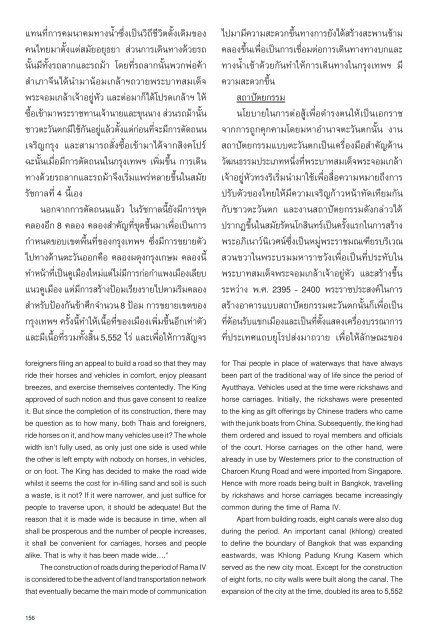บ้านเรือนถิ่นไทยในช่วงเจ็ดทศวรรษ 2489-2559
Create successful ePaper yourself
Turn your PDF publications into a flip-book with our unique Google optimized e-Paper software.
แทนที่การคมนาคมทางน้ำซึ่งเป็นวิถีชีวิตดั้งเดิมของ<br />
คนไทยมาตั้งแต่สมัยอยุธยา ส่วนการเดินทางด้วยรถ<br />
นั้นมีทั้งรถลากและรถม้า โดยที่รถลากนั้นพวกพ่อค้า<br />
สำเภาจีนได้นำมาน้อมเกล้าฯถวายพระบาทสมเด็จ<br />
พระจอมเกล้าเจ้าอยู่หัว และต่อมาก็ได้โปรดเกล้าฯ ให้<br />
ซื้อเข้ามาพระราชทานเจ้านายและขุนนาง ส่วนรถม้านั้น<br />
ชาวตะวันตกมีใช้กันอยู่แล้วตั้งแต่ก่อนที่จะมีการตัดถนน<br />
เจริญกรุง และสามารถสั่งซื ้อเข้ามาได้จากสิงคโปร์<br />
ฉะนั้นเมื่อมีการตัดถนนในกรุงเทพฯ เพิ่มขึ้น การเดิน<br />
ทางด้วยรถลากและรถม้าจึงเริ่มแพร่หลายขึ้นในสมัย<br />
รัชกาลที่ 4 นี้เอง<br />
นอกจากการตัดถนนแล้ว ในรัชกาลนี้ยังมีการขุด<br />
คลองอีก 8 คลอง คลองสำคัญที่ขุดขึ้นมาเพื่อเป็นการ<br />
กำหนดขอบเขตพื้นที่ของกรุงเทพฯ ซึ่งมีการขยายตัว<br />
ไปทางด้านตะวันออกคือ คลองผดุงกรุงเกษม คลองนี้<br />
ทำหน้าที่เป็นคูเมืองใหม่แต่ไม่มีการก่อกำแพงเมืองเลียบ<br />
แนวคูเมือง แต่มีการสร้างป้อมเรียงรายไปตามริมคลอง<br />
สำหรับป้องกันข้าศึกจำนวน 8 ป้อม การขยายเขตของ<br />
กรุงเทพฯ ครั้งนี้ทำให้เนื้อที่ของเมืองเพิ่มขึ้นอีกเท่าตัว<br />
และมีเนื้อที่รวมทั้งสิ้น 5,552 ไร่ และเพื่อให้การสัญจร<br />
foreigners filing an appeal to build a road so that they may<br />
ride their horses and vehicles in comfort, enjoy pleasant<br />
breezes, and exercise themselves contentedly. The King<br />
approved of such notion and thus gave consent to realize<br />
it. But since the completion of its construction, there may<br />
be question as to how many, both Thais and foreigners,<br />
ride horses on it, and how many vehicles use it? The whole<br />
width isn’t fully used, as only just one side is used while<br />
the other is left empty with nobody on horses, in vehicles,<br />
or on foot. The King has decided to make the road wide<br />
whilst it seems the cost for in-filling sand and soil is such<br />
a waste, is it not? If it were narrower, and just suffice for<br />
people to traverse upon, it should be adequate! But the<br />
reason that it is made wide is because in time, when all<br />
shall be prosperous and the number of people increases,<br />
it shall be convenient for carriages, horses and people<br />
alike. That is why it has been made wide....”<br />
The construction of roads during the period of Rama IV<br />
is considered to be the advent of land transportation network<br />
that eventually became the main mode of communication<br />
ไปมามีความสะดวกขึ้นทางการยังได้สร้างสะพานข้าม<br />
คลองขึ้นเพื่อเป็นการเชื่อมต่อการเดินทางทางบกและ<br />
ทางน้ำเข้าด้วยกันทำให้การเดินทางในกรุงเทพฯ มี<br />
ความสะดวกขึ้น<br />
สถาปัตยกรรม<br />
นโยบายในการต่อสู้เพื่อดำรงตนให้เป็นเอกราช<br />
จากการถูกคุกคามโดยมหาอำนาจตะวันตกนั้น งาน<br />
สถาปัตยกรรมแบบตะวันตกเป็นเครื่องมือสำคัญด้าน<br />
วัฒนธรรมประเภทหนึ่งที่พระบาทสมเด็จพระจอมเกล้า<br />
เจ้าอยู่หัวทรงริเริ่มนำมาใช้เพื่อสื่อความหมายถึงการ<br />
ปรับตัวของไทยให้มีความเจริญก้าวหน้าทัดเทียมกัน<br />
กับชาวตะวันตก และงานสถาปัตยกรรมดังกล่าวได้<br />
ปรากฏขึ้นในสมัยรัตนโกสินทร์เป็นครั้งแรกในการสร้าง<br />
พระอภิเนาว์นิเวศน์ซึ่งเป็นหมู่พระราชมณเฑียรบริเวณ<br />
สวนขวาในพระบรมมหาราชวังเพื่อเป็นที่ประทับใน<br />
พระบาทสมเด็จพระจอมเกล้าเจ้าอยู่หัว และสร้างขึ้น<br />
ระหว่าง พ.ศ. 2395 - 2400 พระราชประสงค์ในการ<br />
สร้างอาคารแบบสถาปัตยกรรมตะวันตกนั้นก็เพื่อเป็น<br />
ที่ต้อนรับแขกเมืองและเป็นที่ตั้งแสดงเครื่องบรรณาการ<br />
ที่ประเทศแถบยุโรปส่งมาถวาย เพื่อให้ลักษณะของ<br />
for Thai people in place of waterways that have always<br />
been part of the traditional way of life since the period of<br />
Ayutthaya. Vehicles used at the time were rickshaws and<br />
horse carriages. Initially, the rickshaws were presented<br />
to the king as gift offerings by Chinese traders who came<br />
with the junk boats from China. Subsequently, the king had<br />
them ordered and issued to royal members and officials<br />
of the court. Horse carriages on the other hand, were<br />
already in use by Westerners prior to the construction of<br />
Charoen Krung Road and were imported from Singapore.<br />
Hence with more roads being built in Bangkok, travelling<br />
by rickshaws and horse carriages became increasingly<br />
common during the time of Rama IV.<br />
Apart from building roads, eight canals were also dug<br />
during the period. An important canal (khlong) created<br />
to define the boundary of Bangkok that was expanding<br />
eastwards, was Khlong Padung Krung Kasem which<br />
served as the new city moat. Except for the construction<br />
of eight forts, no city walls were built along the canal. The<br />
expansion of the city at the time, doubled its area to 5,552<br />
156


















